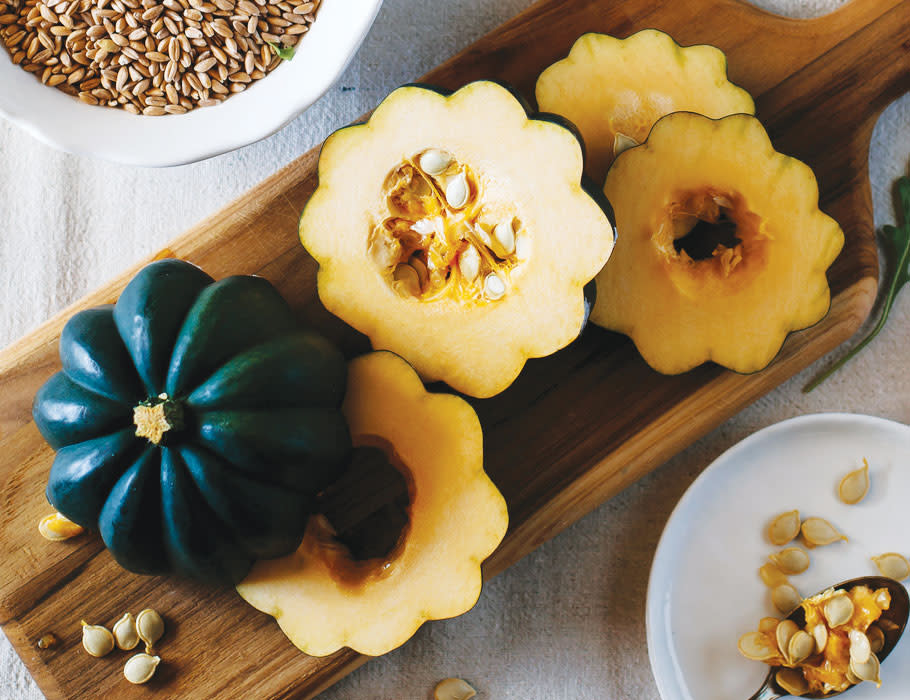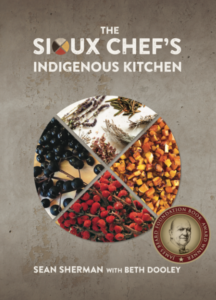A Squash Surrounded in Mystery: Digging Up the History of the Acorn Squash
Did you know that acorn squash is also called Des Moines squash? Learn more about the history and mystery of our lovely little hometown squash.
by Stephanie Fink

Photo: Getty Images
When I sat down to write an article about the humble acorn squash, I had no idea I was about to uncover a mystery. As it turns out, this vegetable has been embroiled in more than one controversy, has been named and re-named multiple times, and has an origin story lost in time. Let me tell you what I’ve learned about one of my personal favorite fall vegetables, and why it’s more than just a nutritious autumn side-dish.
Des Moines Squash
Shortly after becoming a homeowner for the first time several years ago, I noticed a plant starting to send out palm-sized, flat leaves and curling tendrils from a corner behind my back porch. My mother-in-law recognized it as a squash plant, and so my husband and I watched it grow through the spring and summer — big orange blossoms giving way to steady-growing green globes — to see what kind of squash we would get. When the green-and-white spotted fruit finally developed and I began googling, I discovered that acorn squash (my best guess at the time) is also called Des Moines squash, because the variety originates from Des Moines, Iowa — as do I, and as does Cuisine at Home.
That’s the reason I wanted to write about acorn squash — Des Moines squash — in the first place. But it turns out the story of this tasty gourd gets more interesting than that.
Where Does Acorn Squash Come From?
A 2016 Des Moines Register article confirms that "Des Moines Squash is a Thing." But the explanation threw me off. The article cites: “Richard Jauron, a horticulture specialist at Iowa State University Extension, says the acorn squash came to Iowa all the way from Copenhagen, Denmark back in the 1800s.”
Denmark? Isn’t it called Des Moines squash because it’s from Des Moines?
The article goes on to explain that the seed of the now-common deep green acorn squash cultivar, originally named Table Queen, was first sold by a company located in Des Moines, hence the name. But I needed to know if the plant really came here from Denmark, so I did more searching. The entry for acorn squash in the Encyclopedia of American Food and Drink reads: “Sometimes called a ‘Des Moines squash,’ this American winter fruit was long favored by Native Americans.”
Hmm. Now, this was hinting at an entirely different origin story.
The Harvesting History website sums it up this way: “A squash surrounded in mystery, Table Queen was introduced in 1913 by the Iowa Seed Company. The seed had either come from Denmark or the Dakotas.”
Now I was more intrigued than ever, and needed to know: which place did this plant come from originally? Denmark, or the Dakotas?
Squash: An Ancient American Food
I learned from Wikipedia and other sources that many of the squash varieties we know and love in the United States today — including pumpkins, acorn squash, and zucchini — all belong to a species group that originated and was first cultivated in the Americas thousands of years ago: Cucurbita pepo. It was a staple of the Indigenous diet; one of the “Three Sisters” crops essential to many Native American tribes: squash, corn, and beans, and the first one to be domesticated by them. Squash wasn’t introduced to Europeans until the 16th century, when Indigenous Americans traded it to them. The English word “squash” comes from a Native American word.
So this must mean that the acorn squash — or at least its predecessor — came from America originally. Was it brought back from Denmark? How long had it been there, and how much had it been changed?
The Controversial Acorn Squash
A truly delightful 1927 document titled “A Systematic Study of Squashes and Pumpkins” from the Iowa State College of Agriculture sheds some light. It calls the Danish origin of the Table Queen into “serious question,” saying that no evidence of the variety can be found in the European seed trade, and citing a seedsman from Denmark who attests that squash cannot be grown in that climate. (Hah!) It also includes testimony of a similar squash grown by the Arikara tribe in North Dakota.
Additionally, the Systematic Study tells an unrelated story of an “enterprising Wyoming seedsman” who in 1924 tried to pass the acorn squash off as a new vegetable called a “yama,” which he claimed was a cross between sweet corn and hubbard squash. He was exposed as a fraud, but not before successfully selling his entire harvest to an unsuspecting railroad company.
And finally, I learned that Table Queen broke the code of agricultural nomenclature when it was renamed Des Moines squash at the 1919 convention of the Iowa Vegetable Growers’ Association to appease the Market Gardeners’ Association of Des Moines, who felt they deserved some credit. The name change was later reversed, and the cultivar that we now know simply as acorn squash (which is also the name of the variety) has gone by several other names throughout its history: Danish, Delicious, Kitchenette, Individual, and Pepper squash.
Des Moines Squash: The True Story
So. What’s the real story of the acorn squash? It’s true that Europeans have been cultivating squash that was brought back from the Americas since as early as the 1500s. But it also seems doubtful that Table Queen was cultivated in Europe. I think the likeliest version of this vegetable’s story is that this was one of several squash varieties long grown by the women of the Arikara tribe of the Great Plains region, who were renowned cultivators and farmers. After a long history in the hands of Indigenous people, it made its way to Des Moines in the late 1800s by way of Robert Fullerton who gave the seeds, which he claimed to have found in Copenhagen, to Sestier Brothers in Des Moines, who then grew and popularized the squash locally, whereby it eventually became commercialized by the Iowa Seed Company in 1913.
Perhaps Fullerton was lying about where he found the seeds, or maybe he was confused, or someone misreported his claim. Or perhaps he really did discover an unsung squash cultivar that showed up in Copenhagen against the odds. Whatever the case, the rest is history.
Native American Heritage
“North America’s history begins with Indigenous history.” This is the message of Sean Sherman, also known as The Sioux Chef, winner of the 2018 James Beard Award for Best American Cookbook. In that book, The Sioux Chef’s Indigenous Kitchen, he calls the acorn squash “an ancient variety.” His team is working to re-identify and revitalize North American Cuisine, and make it more accessible to as many communities as possible. His Lakota ancestors were neighbors to the Arikaras and depended upon trading with them for food during times of peace, as did several other tribes. In this way, the acorn squash was integral to many tribes’ livelihood, as well as the relationships among them.

Before I began this research, I imagined the acorn squash as something that spontaneously emerged from the rich soil of Central Iowa, just like that hardy little plant behind my back porch. But this is a plant — and a food — whose history is wide-ranging and tied to that of the people who first cultivated it and depended upon it. They expertly grew this squash not just for sustenance, but also to strengthen their human relationships, in much the same way that we (normally) create and share a Thanksgiving meal as a way of reinforcing the bonds within our families.
We have the Indigenous people of this country to thank for many of our most important culinary foundations. We also have the seedmen of turn-of-the-century Des Moines to thank for one of the four most popular squashes in the country today.
And, just maybe, we have the Danes to thank for it as well.
Happy National Native American Heritage Month!

Like acorn squash? Try our recipe for Baked Acorn Squash with Brown Sugar & Mustard. Check out our tip for How to Cut Hard Winter Squash. And — my personal favorite — try using puréed roasted acorn squash in place of pumpkin in our Creamy Pumpkin Soup with bacon & roasted pumpkin seeds.
Product Recommendations
Interested in cooking? Need some supplies?
Check out some of the tools we like. All products featured on Cuisine at Home are independently selected by our editors; we may earn an affiliate commission from qualifying purchases through our links.